
Batik is an Indonesian technique of wax-resist dyeing applied to the whole cloth. This technique originated from the island of Java, Indonesia. Batik is made either by drawing dots and lines of the resist with a spouted tool called a canting, or by printing the resist with a copper stamp called a cap. The applied wax resists dyes and therefore allows the artisan to colour selectively by soaking the cloth in one colour, removing the wax with boiling water, and repeating if multiple colours are desired.
Ikat is a dyeing technique originating from Indonesia used to pattern textiles that employs resist dyeing on the yarns prior to dyeing and weaving the fabric.

A sarong or a sarung is a large tube or length of fabric, often wrapped around the waist, worn in Southeast Asia, South Asia, Western Asia, Northern Africa, East Africa, West Africa, and on many Pacific islands. The fabric often has woven plaid or checkered patterns, or may be brightly colored by means of batik or ikat dyeing. Many modern sarongs have printed designs, often depicting animals or plants. Different types of sarongs are worn in different places in the world, notably the lungi in the Indian subcontinent and the izaar in the Arabian Peninsula.

The culture of Indonesia has been shaped by long interaction between original indigenous customs and multiple foreign influences. Indonesia is centrally-located along ancient trading routes between the Far East, South Asia and the Middle East, resulting in many cultural practices being strongly influenced by a multitude of religions, including Buddhism, Christianity, Confucianism, Hinduism, and Islam, all strong in the major trading cities. The result is a complex cultural mixture, often different from the original indigenous cultures.
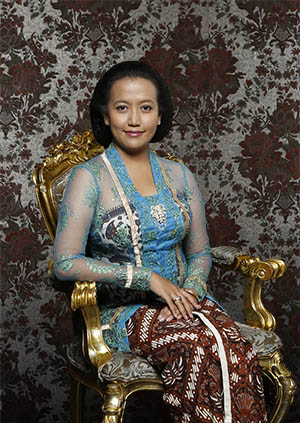
A kebaya is an upper garment traditionally worn by women in Southeast Asia, notably in Brunei, Indonesia, Malaysia, Singapore and Southern Thailand. Outside of Southeast Asia, it is worn by Javanese, Malays and Portuguese Eurasians in Australian Cocos Islands and Christmas Island, coastal India and Sri Lanka, Macau as well as South Africa.
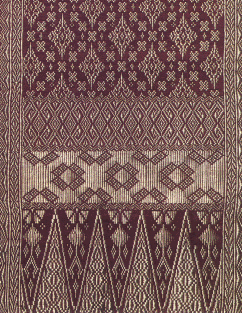
Songket is a Tenun fabric that belongs to the brocade family of textiles of Brunei, Indonesia, Malaysia and Singapore. It is hand-woven in silk or cotton, and intricately patterned with gold or silver threads. It is hand-woven in silk or cotton, and intricately patterned with gold or silver threads. The metallic threads stand out against the background cloth to create a shimmering effect. In the weaving process the metallic threads are inserted in between the silk or cotton weft (latitudinal) threads in a technique called supplementary weft weaving technique.
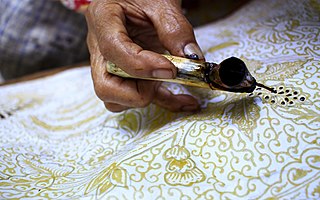
Resist dyeing (resist-dyeing) is a traditional method of dyeing textiles with patterns. Methods are used to "resist" or prevent the dye from reaching all the cloth, thereby creating a pattern and ground. The most common forms use wax, some type of paste made from starch or mud, or a mechanical resist that manipulates the cloth such as tying or stitching. Another form of resist involves using a chemical agent in a specific type of dye that will repel another type of dye printed over the top. The best-known varieties today include tie-dye, batik, and ikat.

Stanley Ann Dunham was an American anthropologist who specialized in the economic anthropology and rural development of Indonesia. She is the mother of Barack Obama, the 44th president of the United States. Dunham was known as Stanley Ann Dunham through high school, then as Ann Dunham, Ann Obama, Ann Soetoro, a.k.a. Ann Sutoro, and resumed her maiden name, Ann Dunham, later in life.

Pakaian is the term for clothing in Malaysia's national language. It is referring to things to wear such as shirts, pants, shoes etc. Since Malaysia is a multicultural nation: Malay, Chinese, Indian and hundreds of other indigenous groups of Malay peninsula and Borneo, each has its own traditional and religious articles of clothing all of which are gender-specific and may be adapted to local influences and conditions. Previously, traditional clothes were worn daily. However, by excluding Baju Melayu, Baju Kurung many are now only worn on special occasions such as marriage ceremonies and cultural events.

Malaysian batik is batik textile art in Malaysia, especially on the east coast of Malaysia. The most popular motifs are leaves and flowers. Malaysian batik depicting humans or animals are rare because Islam norms forbid animal images as decoration. However, the butterfly theme is a common exception. Malaysian batik is also famous for its geometrical designs, such as spirals. The method of Malaysian batik making is also quite different from those of Indonesian Javanese batik, the pattern is larger and simpler, it seldom or never uses canting to create intricate patterns and relies heavily on brush painting method to apply colours on fabrics. The colours also tend to be lighter and more vibrant than the deep coloured Javanese batik.

Tapis is a traditional Tenun style and also refers to resulting cloth that originated from Lampung, South Sumatra, Indonesia. It consists of a striped, naturally-coloured cloth embroidered with warped and couched gold thread. Traditionally using floral motifs, it has numerous variations. It is generally worn ceremonially, although it can be used as a decoration. It is considered one of the symbols of Lampung and Lampungese.
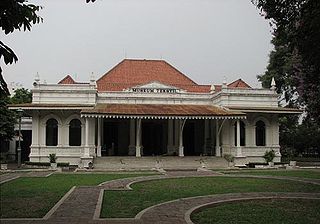
The Textile Museum is a museum in Palmerah, West Jakarta, Indonesia. The museum houses a collection of textiles from various islands in Indonesia.
Iwan Tirta was an Indonesian batik fashion designer. Tirta trained as a lawyer, but became an internationally known designer. He is credited with beginning the early revival of batik design during the 1970s and 1980s. He also became an Indonesian and Javanese cultural advocate, as well as a food consultant, later in his career.

The national costume of Indonesia is the national costume that represents the Republic of Indonesia. It is derived from Indonesian culture and Indonesian traditional textile traditions. Today the most widely recognized Indonesian national costumes include batik and kebaya, although originally those costumes mainly belong within the island of Java and Bali, most prominently within Javanese, Sundanese and Balinese culture. Since Java has been the political and population center of Indonesia, folk costume from the island has become elevated into national status.

Balinese textiles are reflective of the historical traditions of Bali, Indonesia. Bali has been historically linked to the major courts of Java before the 10th century; and following the defeat of the Majapahit kingdom, many of the Javanese aristocracy fled to Bali and the traditions were continued. Bali therefore may be seen as a repository not only of its own arts but those of Java in the pre-Islamic 15th century. Any attempt to definitively describe Balinese textiles and their use is doomed to be incomplete. The use of textile is a living tradition and so is in constant change. It will also vary from one district to another. For the most part old cloth are not venerated for their age. New is much better. In the tropics cloth rapidly deteriorates and so virtue is generated by replacing them.

Indonesia–Panama relations was established in 1979. Since the beginning, both countries has realized the strategic importance of each counterparts; Indonesia sees strategic and geographic importance of Panama as their gate to Central America as well as to reach the Caribbean region, while Panama also has recognized the strategic importance of Indonesia in ASEAN region. Indonesia has an embassy in Panama City, while Panama has an embassy in Jakarta.

Batik Day is an Indonesian cultural day for celebrating batik – the traditional cloth of Indonesia. It is celebrated on October 2 and marks the anniversary of when UNESCO recognized batik as a Masterpiece of Oral and Intangible Heritage of Humanity in 2009. At the day, in Jakarta, the map of Indonesian batik diversity by Hokky Situngkir was opened for public for the first time by the Indonesian Ministry of Research and Technology. The Indonesian government strongly encourage Indonesian people to wear batik annually on the holiday and on Fridays to commemorate the day. Wearing batik every Friday has also been encouraged in private companies.

It is quite difficult to define Indonesian art, since the country is immensely diverse. The sprawling archipelago nation consists of 17.000 islands. Around 922 of those permanently inhabited, by over 1,300 ethnic groups, which speak more than 700 living languages.
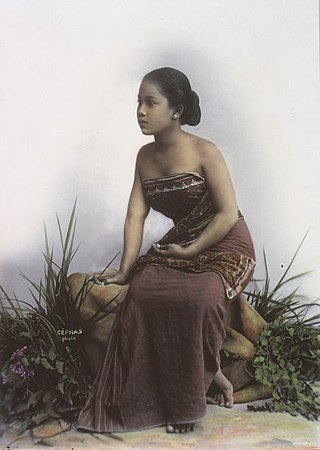
Kemben is an Indonesian female torso wrap historically common in Java, Bali, and other part of Indonesian archipelago. It is made by wrapping a piece of kain (clothes), either plain, batik printed, velvet, or any type of fabrics, covering the chest wrapped around the woman's torso.

Tenun is an artful Indonesian technique of making a fabric by weaving different colours of threads. Tenun belongs to one of the typical Indonesian cultural arts produced by hand skills using traditional looms. The word Tenun itself has a high meaning, historical value, and technique in terms of colors, motifs, and types of materials and threads used and each region has its own characteristics. In addition, Tenun is also one of Indonesia's original cultural heritages that is still maintained and preserved to this day.


















